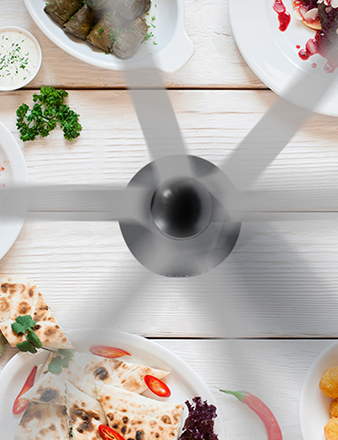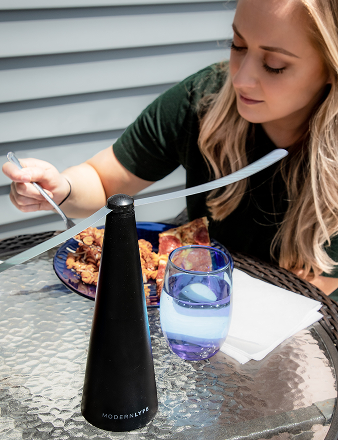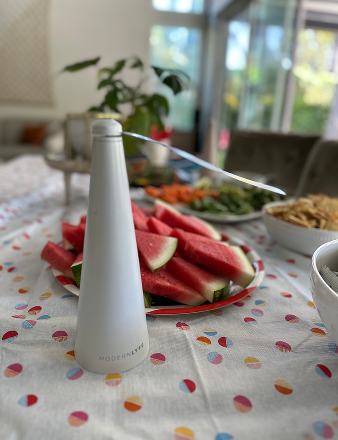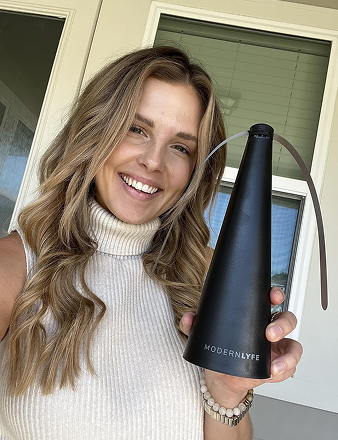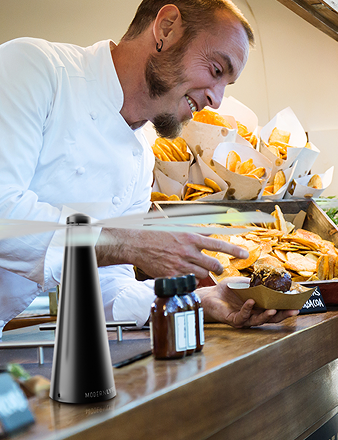Fly control for restaurants isn’t just about swatting pests. It’s about protecting public health and your business. One fly can make a customer doubt your cleanliness or attract a health inspector's attention, putting your reputation on the line.
Why Getting Fly Control Right Is Non-Negotiable
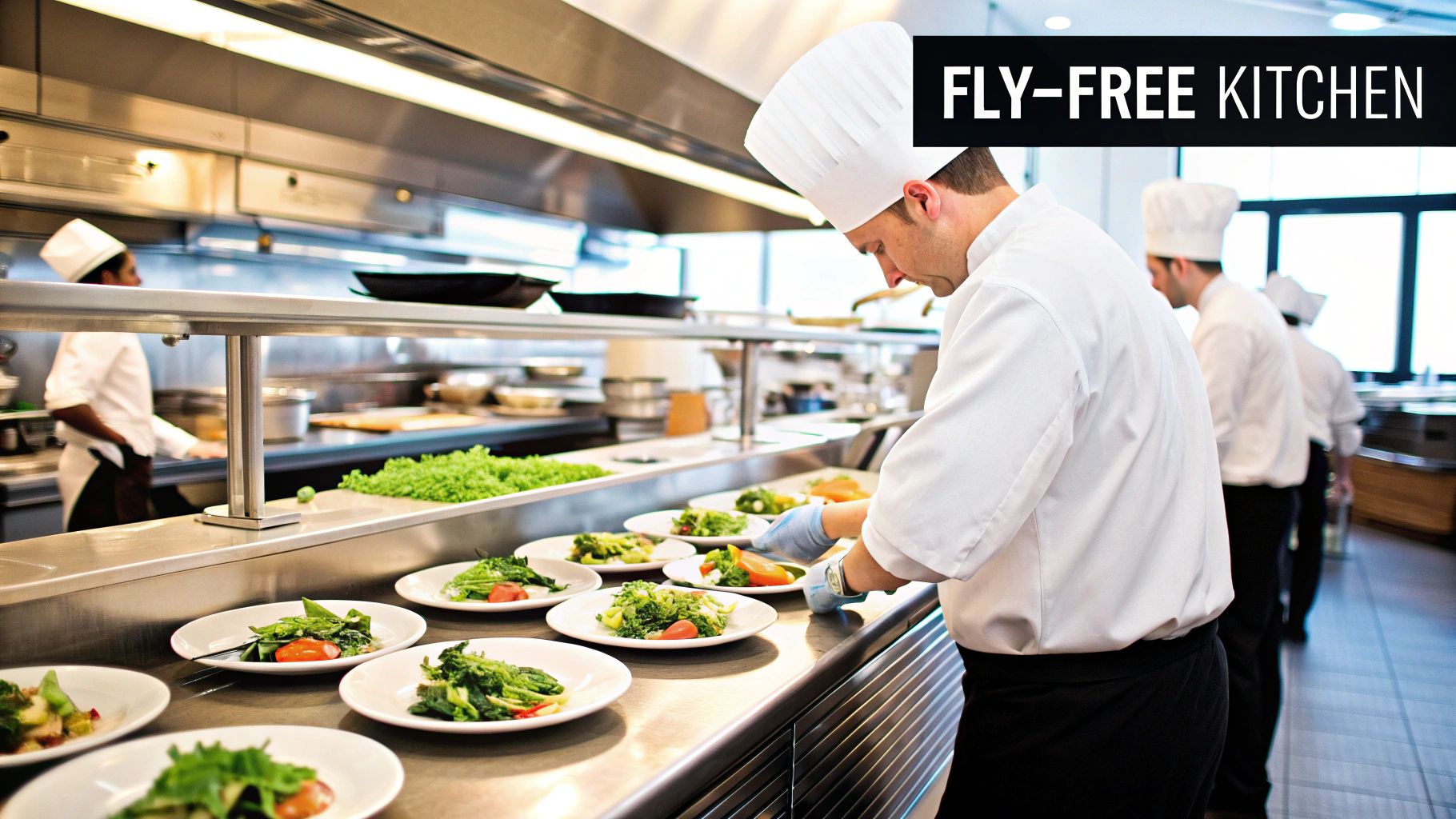
Let's be direct: flies are a serious threat to your restaurant. They aren't just an annoyance; they're a direct risk to your reputation, your customers' health, and your bottom line. The sight of flies often leads to negative online reviews, customer complaints, and failed health inspections.
These insects are notorious carriers of pathogens. A fly doesn't care if it just landed on a dumpster, in a drain, or on animal waste. It picks up germs and walks them all over your prep stations, utensils, and food. We're talking about bacteria like Salmonella, E. coli, and Shigella delivered straight to your customers.
The Unseen Enemy in Your Kitchen
Most restaurants battle the same three culprits: house flies, fruit flies, and drain flies. Each type has its preferred hangout, but they all want what your kitchen offers: food, warmth, and moisture.
Flies are persistent because they can smell food from a distance and are experts at finding accumulated food waste. They slip in through open doors, unsecured windows, or tiny gaps in your ventilation. Once inside, they can live for nearly a month and reproduce at an alarming rate, especially in damp, decaying organic material found in trash cans or poorly cleaned drains. For a deeper dive, check out this helpful food safety guide.
A single female house fly can lay up to 500 eggs in just a few days. A minor fly problem can explode into a full-blown infestation if you're not on top of it.
Understanding this is the first step. If you're just swatting at the flies you see, you're already losing. A winning strategy is all about prevention.
Building the Foundation of a Clean Restaurant
This proactive mindset is called Integrated Pest Management (IPM). An IPM plan isn't a one-time fix; it's a continuous system that combines top-notch sanitation, physical exclusion (blocking them out), and smart, targeted controls. The goal is to make your restaurant an environment where pests can't thrive.
It’s about cutting the problem off at the source by finding and eliminating their breeding grounds. Every restaurant owner needs to be obsessed with these key areas:
- Garbage and Recycling: Overflowing bins are a welcome mat for flies.
- Drains and Plumbing: Grimy, damp floor drains are a five-star hotel for drain flies.
- Food Storage: Spilled sugar or unsealed produce will attract fruit flies.
- Hidden Spills: Forgotten food debris under heavy equipment is a common culprit.
To help you get started, here's a quick-reference table that pinpoints the usual suspects and what to do about them.
Common Fly Hotspots and Prevention Actions
| Hotspot Area | Type of Fly | Primary Prevention Action |
|---|---|---|
| Garbage Bins & Dumpsters | House Fly | Use sealed lids; schedule frequent emptying; clean bins regularly. |
| Bar & Soda Stations | Fruit Fly | Wipe up spills immediately; clean soda fountain drip trays daily. |
| Floor & Sink Drains | Drain Fly | Clean drains with a stiff brush and enzyme-based cleaner. |
| Food Prep & Storage | House Fly, Fruit Fly | Store all food in airtight containers; clean up spills and crumbs. |
| Mop Sinks & Closets | Drain Fly, House Fly | Ensure mops are hung to dry completely; keep the area clean and dry. |
By consistently tackling these hotspots, you aren't just cleaning—you're building the foundation for a safer, more successful restaurant. This is how you stay ahead of the problem.
Your First Line of Defense in Fly Prevention
To keep flies out of your restaurant, you have to build a fortress. The best fly control isn't about swatting the one that gets in; it's about making your establishment so unappealing to them they never even try. This means getting serious about denying them what they're looking for: a meal and a place to lay eggs.
From a fly's perspective, a faint whiff from a drain, a sticky spot under the bar, or a tiny crack near the back door is an open invitation. Your job is to systematically shut every one of those doors. This requires a non-negotiable commitment to sanitation and exclusion.
Creating an Unbreachable Barrier
Your defense strategy starts at the property line. Flies are masters at finding the path of least resistance, so you need to walk your building's exterior with a critical eye, looking for any potential entry point.
Once you’ve identified weak spots, create physical barriers. Your doors are the main gateways and need to be actively protected.
- Seal Every Gap: Routinely check window screens, door frames, and even the building's foundation for tiny cracks. A little caulk or weather stripping goes a long way in blocking these insect highways.
- Install Air Curtains: For entrances with constant traffic, like the main door or delivery dock, an air curtain is a game-changer. It creates a powerful wall of air that flies can't push through.
- Check Your Door Sweeps: The gap at the bottom of your back door might as well be a welcome mat. Every exterior door needs a tight-fitting sweep that scrapes the threshold, leaving zero room for anything to crawl under.
These exclusion tactics are your first and best defense, making it incredibly difficult for flies to get inside.
Weaponize Your Cleaning Schedule
With the perimeter secured, the fight moves indoors. Relentless sanitation is your most powerful weapon. This isn't a basic "wipe down the counters" checklist. You need a detailed, targeted cleaning schedule that hits the grimy, hidden spots where flies live and breed.
I've seen it a hundred times: a manager is proud of their sparkling dining room while the real problem is festering under the cook line. Flies don't care about shiny floors; they thrive on the gunk in floor drains and forgotten spills on the dumpster pad.
To make your cleaning truly effective, break it down into daily, weekly, and monthly missions.
Your Actionable Cleaning Protocol
- Daily Tasks: Eliminate immediate food sources. Every night, treat floor drains with an enzyme cleaner, scrub all prep surfaces, clean soda fountain trays, and empty, wash, and dry every trash can. No exceptions.
- Weekly Tasks: Go deeper. Pull heavy equipment away from the walls and scrub the floors and walls behind them. Power wash the dumpster pad to blast away grime. Clean and sanitize all dry storage shelving.
- Monthly Tasks: This is your full-scale deep clean. Scrub walls and ceilings, and hunt for any hidden leaks or moisture problems that could create a damp breeding ground.
By combining disciplined exclusion with a military-grade cleaning regimen, you build a preventative system that truly works. This proactive mindset shifts your restaurant from being a target to being a fortress.
To dig deeper into fortifying your space, check out our complete guide on how to keep flies away from food. This robust defense is the foundation of superior fly control for restaurants.
How Flies Threaten Public Health
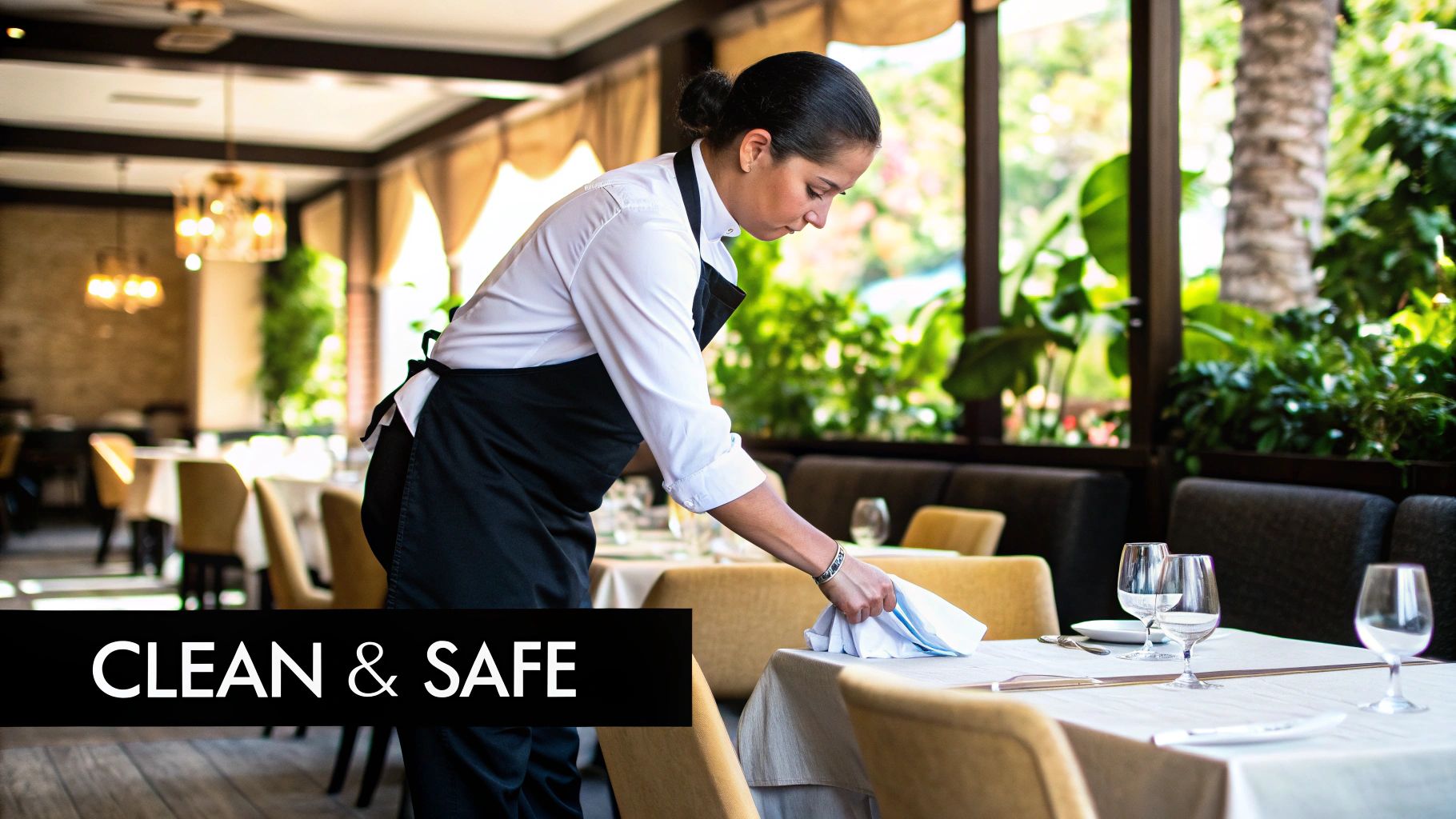
That fly in your dining room isn’t just a nuisance. It’s a mobile biohazard. As a restaurant owner, you need to understand the direct line between a single fly and a potential health crisis. When your team truly gets the "why" behind strict sanitation rules, they become your first line of defense.
Flies have disgusting habits that make them expert germ couriers. They thrive on filth—landing on garbage, animal waste, and greasy drains—where pathogens stick to their hairy legs and bodies. Moments later, that same fly lands on a clean plate, a prep counter, or a customer's meal, depositing contaminants right where you don't want them.
This isn’t just a theory; it's a documented public health risk. The common house fly is a known carrier for a host of dangerous bacteria.
From Filth to Food: The Pathogen Pathway
A single fly's journey can unleash a microscopic disaster in your kitchen. They don't just track germs on their feet. Flies can't chew solid food, so they regurgitate digestive fluids to liquefy it, and they defecate constantly, leaving a trail of potential disease everywhere they land.
This process can happen in seconds. A fly from your dumpster can land on a cutting board, transferring E. coli or Salmonella and setting the stage for a foodborne illness outbreak. This is exactly why effective fly control for restaurants isn't just a "nice to have"—it's an essential part of food safety.
The real danger of a fly isn't just its presence, but its history. A fly doesn't distinguish between a pile of garbage and a freshly prepared plate, making it a perfect vehicle for cross-contamination.
This knowledge should be the foundation of your staff training. When your crew sees a fly not as an insect but as a direct threat to a customer's health, their commitment to your cleaning protocols will skyrocket.
The Science Behind the Threat
The research is clear. House flies (Musca domestica) are major vectors for spreading pathogens that cause serious human illnesses, especially diarrheal diseases. Globally, these pests contribute to staggering public health costs—some estimates put it as high as $1 billion a year in healthcare and lost productivity. Studies repeatedly show that aggressive fly control programs can dramatically cut disease rates. You can dig into the data yourself to understand the public health impact of flies on jipm.com.
Suddenly, every cleaning task takes on new importance. Scrubbing a floor drain, wiping a counter, or ensuring a garbage bin is sealed isn't just a chore. It's a deliberate act to break the chain of transmission and protect every guest who trusts you with their meal.
Strategic Use of Modern Fly Control Tools
Once you’ve locked down your sanitation protocols and installed physical barriers, it’s time for active defense. Modern tools like insect light traps (ILTs), glue boards, and fly fans are the next essential layer in a solid Integrated Pest Management (IPM) plan. But just buying the gear isn't enough. Its real power comes from putting it in the right place.
Placement can make or break your entire effort. It’s the difference between a tool that solves your fly problem and one that actually makes it worse. A classic mistake is putting an insect light trap right by an entrance. The UV light acts like a neon "welcome" sign, luring more pests from outside.
Maximizing Your Tool's Effectiveness
To get your money's worth, think like a fly. Where do they get in? What are their flight paths? Where do they rest? By placing tools along these routes, you can intercept them long before they reach your dining room or prep areas.
This is especially true for creating air barriers. Flies are weak flyers, and a steady current of air can stop them in their tracks. It's simple physics that works wonders for protecting open spaces. You can create an invisible shield over high-traffic spots like patio doors, server pass-through windows, and buffet lines.
For a solution that’s both effective and doesn't disrupt the dining experience, a strategically placed Modern Lyfe Fly Fan is perfect. It keeps tables clear of pests without using chemicals or making a racket.
The goal with modern tools isn’t just catching the flies you see. It’s creating an environment so unwelcoming that they can't thrive. This is proactive control, not reactive cleanup.
The image below gives you a great visual on how different barriers work together to create a fortress around your establishment.
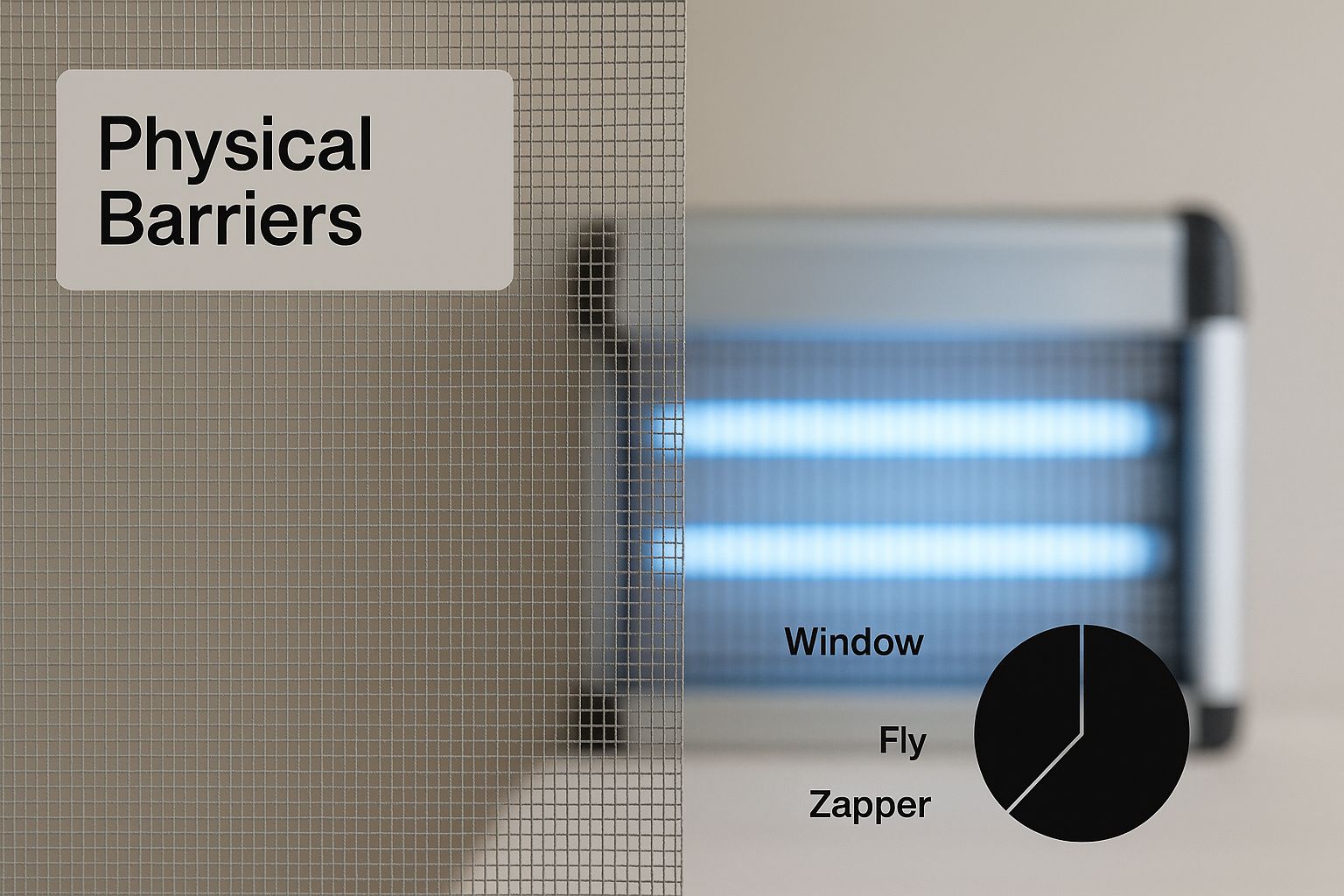
As you can see, things like window screens and zapper traps are crucial, but they work best when combined with smart sanitation and other modern devices.
A Practical Placement Guide
An effective fly control for restaurants plan uses different tools for different zones. Every device has a job, and putting it in the right spot ensures it does that job well. It's like posting guards where they’ll see the most action.
The key is understanding which tool works best in which part of your restaurant. This table breaks down where to place your gear for the best results.
Fly Control Tool Placement Guide
| Control Tool | Optimal Placement Area | Placement To Avoid | Key Benefit |
|---|---|---|---|
| Insect Light Trap (ILT) | Interior hallways, near kitchen entrances, away from doors/windows | Directly in view of exterior doors or over food prep surfaces | Intercepts flies that have already breached the perimeter |
| Glue Boards | Under bars, behind heavy equipment, in dry storage areas | In high-visibility dining areas or dusty environments | Discreetly traps crawling insects and low-flying pests |
| Fly Fans | On dining tables, buffet lines, pass-through windows, patio tables | In windy areas where their air current is disrupted | Creates a chemical-free barrier to protect food and guests |
By layering these tools, you build overlapping fields of protection. This multi-faceted approach tackles flies at every possible point of contact—from the back dock to the customer’s table.
It's easy to wave away a fly and think of it as a minor nuisance. But in a professional kitchen, that single fly is a tiny, winged biological hazard. They are documented carriers of nasty pathogens. Think of them as six-legged delivery drones for bacteria.
Flies live a disgusting life. One minute they’re feasting on rotting garbage or animal feces, and the next they’re landing on your sanitized prep counter. Their bodies and legs are covered in microscopic hairs that are like Velcro for germs. When a fly touches down, it's not just resting; it's dropping off a minefield of invisible contaminants.
The Threat You Can't See
The real danger is what you can't see. A single fly can introduce bacteria like Salmonella and E. coli onto cutting boards, utensils, and ready-to-serve food. The transfer is quick, silent, and invisible. This is why a proactive fly control for restaurants strategy must be a non-negotiable part of your food safety protocol.
Think about your HACCP plan. It's designed to manage hazards at every critical point. A fly can contaminate food moments before it reaches a customer, making it a critical failure point that requires constant attention.
This isn't just a "what if" scenario. The science backs it up. An eye-opening 2006 study collected house flies from fast-food restaurants and found that a staggering 97% of them carried bacteria that could make people sick. You can discover more about these alarming findings on abcnews.go.com. A number like that drives home why you can't be complacent.
A Modern Health Crisis on Wings
What was most unsettling from that same research was the discovery that many of the bacteria found on these flies were resistant to common antibiotics. This means flies aren't just spreading sickness—they could be helping to spread antibiotic-resistant "superbugs," one of the biggest public health challenges today.
When a fly lands in your kitchen, it might be introducing microbes that are incredibly difficult for doctors to treat. This fact elevates fly control from a simple cleaning task to an essential public health duty. A fly can carry a host of dangerous pathogens, including:
- Campylobacter: A top cause of foodborne diarrheal illness.
- Shigella: A bacteria that can lead to severe dysentery.
- Listeria: A dangerous pathogen that can survive and grow in refrigerated temperatures.
- Staphylococcus aureus: A common cause of food poisoning.
Understanding this direct line between flies and disease is the first step. Every time you get rid of a fly or its breeding spot, you're doing more than just keeping things clean—you're actively protecting your customers from unseen dangers and defending the reputation you've worked so hard to build.
Common Questions About Restaurant Fly Control
Even with the best plan, questions pop up. When it comes to something as critical as fly control in a restaurant, clear answers are key to feeling confident in your strategy. Let's tackle some of the most common concerns.
How Often Do I Need Professional Pest Control?
For most restaurants, monthly professional service is a good starting point for a proactive IPM program. But this isn't a one-size-fits-all situation. The right frequency depends on your specific circumstances—your climate, the season, and your building's quirks.
If your restaurant is in a hot, humid area or next to a shared dumpster, you'll likely need more frequent visits, maybe even bi-weekly during peak summer months. A good pest control partner won’t just show up and spray. They’ll assess your unique risks and build a monitoring schedule that keeps you ahead of the game.
Are DIY Fly Repellents Effective in a Commercial Kitchen?
While things like hanging bags of water or using essential oils might have a small effect at home, they are not powerful enough for a commercial restaurant environment. The constant flow of enticing food smells and numerous entry points will overwhelm any weak, passive repellent.
Relying on DIY solutions in a professional kitchen gives you a false sense of security. It's how a small issue blows up into a full-blown infestation that can tank your reputation and lead to health code violations.
A real commercial strategy must be built on proven, professional-grade methods. This means relentless sanitation, mastering exclusion (sealing every crack and fortifying doors), and using tools built for the job, like ILTs and glue boards. The best way to banish buzzing pests is with a Modern Lyfe fly fan for tables, which actively protects your dining areas without chemicals.
What Is the Biggest Fly Control Mistake Restaurants Make?
Hands down, the biggest mistake is being reactive instead of proactive. Many operators wait until they see flies to do something. They grab a can of spray or a fly swatter for a quick fix, but that approach misses the point. You're just swatting at symptoms, not curing the disease.
The only way to win this fight is to eliminate their food and breeding grounds. This comes down to disciplined, consistent sanitation—deep-cleaning floor drains, managing garbage disposal, and getting to hidden spills under equipment. If you don't nail this foundational work, every other tool is just a temporary bandage on a problem that will keep coming back.
Ready to create a more pleasant dining atmosphere for your guests? Explore the elegant and effective solutions from Modern Lyfe to keep your tables fly-free. Visit https://modernlyfe.com to find the perfect fan for your restaurant.

